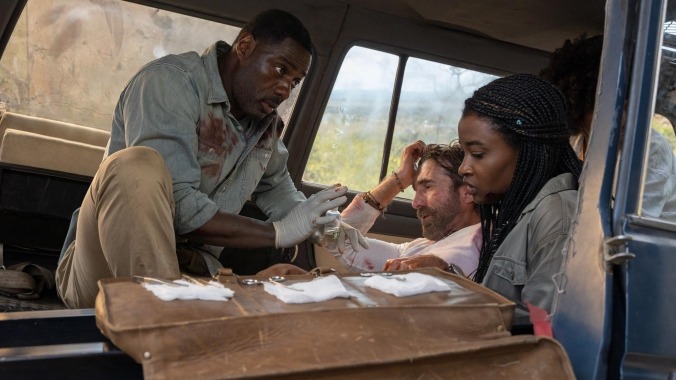Beast takes pride in the cinematic pleasures of an animal attack
Idris Elba stars for director Baltasar Kormákur, who strips down this man-vs.-lion story to its skeletal best
Film Reviews Beast
Sometimes the simplest pleasures are ones most worth pursuing. Simple does not necessarily mean stupid, incoherent, or lacking in craft, as an entire history of B-movie cinema (much less late-summer box office distractions) has proven, and the firmly-in-the-latter-category Beast serves as a prime example of how to do simple right. Director Baltasar Kormákur continues here in his particular niche of survivalist stories, trading in the oceanic expanse of Adrift and Everest’s treacherous heights for animalistic terror, demonstrating an understanding of tension and escalation that many films, even ones with much bigger budgets, fail to grasp.
That begins with a story by Jaime Primak Sullivan and a screenplay by Ryan Engle that is, well, uncomplicated. Dr. Nate Samuels (Idris Elba) brings his teenage daughters Mere (Iyana Halley) and Norah (Leah Jeffries) to South Africa to connect with their mother’s roots after she passes away from cancer. As they stay with family friend and conservationist Martin (Sharlto Copley), it becomes clear that, despite an outwardly peaceful family dynamic, Mere blames her father for being absent during her mother’s final months, Nate is wracked with guilt over unresolved cracks in his marriage, and Norah desperately tries her best to keep the peace. These concerns soon become secondary after Martin and the Samuels encounter a village that’s been slaughtered—and a lion driven mad by the poaching of its entire pride.
Though the central conflicts are about as rote as dad movies get, they sufficiently explain these characters’ motivations, even as the Samuels get into an escalating series of extreme situations. Though not quite a single-location thriller, much of Beast’s second act takes place around a crashed jeep that the lion becomes determined to break into, and the amount of drama extracted from that singular set-up is impressive. Whether Nate and Martin are butting heads over Martin’s self-sacrificing instincts, Mere is making adolescent impulsive decisions to put herself at risk, or Norah is demonstrating surprisingly nimble thinking in a deadly situation, these characters put the audience in that cab as the jeep becomes their one refuge from the beast.
To amplify the tension, Kormákur and cinematographer Philippe Rousselot shoot scenes as extended single takes, treating the camera as an invisible fifth character that not only occupies the others’ space but physically follows the action and character beats. It’s a compelling stylistic choice that turns characters’ simple movements between locations into twisting journeys where the unknown might be just out of the line of sight—the characters’ and the audience’s.
At the same time, these long takes occasionally have trouble tracking plot-vital information in cramped scenarios or less-maneuverable moments, with dubbed dialogue filling gaps the filmmakers failed to capture on film. Thankfully this issue, while pervasive, is not so obvious that it breaks suspension of disbelief, but it’s a notable trade off for a film that otherwise might have been much less engaging visually.
Further, the digitally rendered lion does look quite good in motion, mostly avoiding the uncanny valley of the Lion King remake by declining to personify the lion beyond its vengeful rage. Its motion and attack patterns feel authentic and calculating for a predatory cat, which goes a long way toward smoothing over a couple of instances where the plot contrives some scenarios that one would only expect a slasher villain or a Looney Toons character to walk away from with barely a scratch. But when that inevitable confrontation finally arrives between Elba and his feline nemesis, its pure brutality is as impressive as it is gripping, earning the visual effects team kudos for such remarkable believability.
In fact, that’s probably what’s most compelling about Beast: it’s believable. For a singularly outlandish and specific premise, this is a film that lets its audience experience the horror right along with the characters on screen. This is cinema as spectacle distilled down to its rawest form, where basic storytelling leads directly to visceral and emotional catharsis. That Beast manages to be quite so powerful offers a welcome reminder that simple pleasures can still occupy an essential place at the movies.